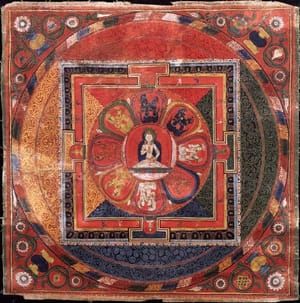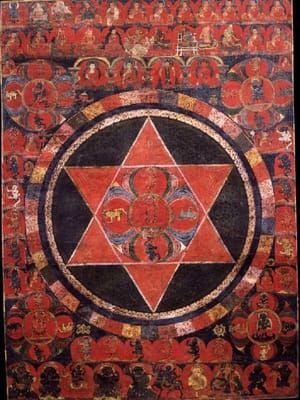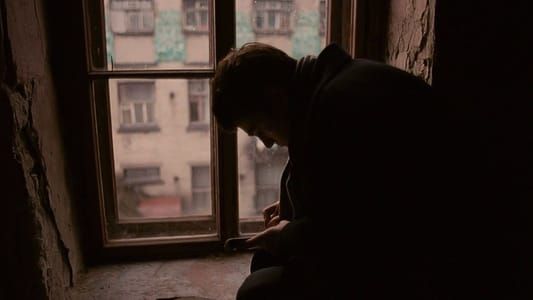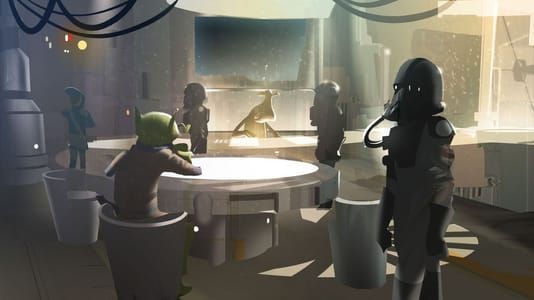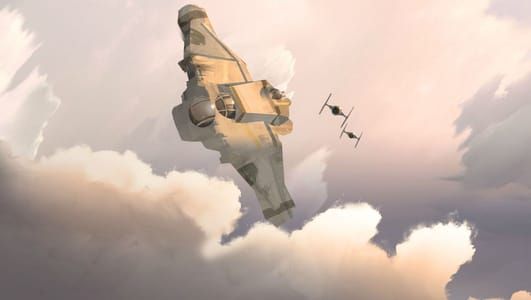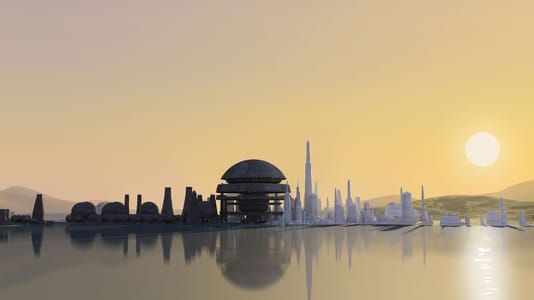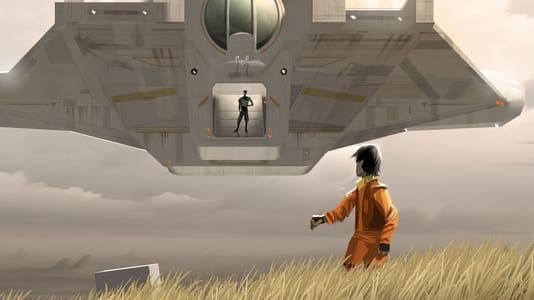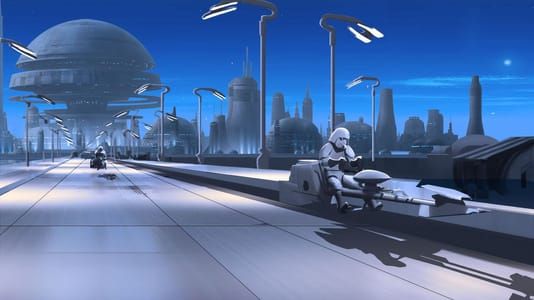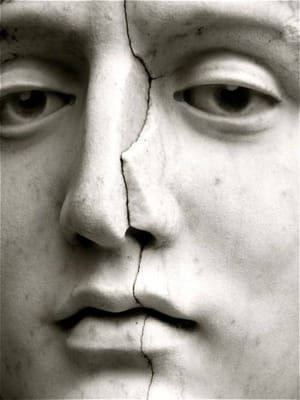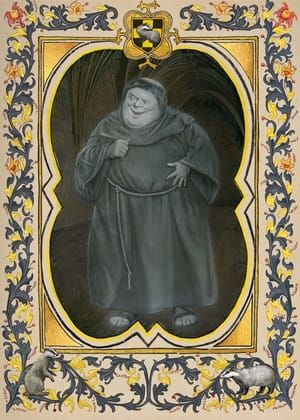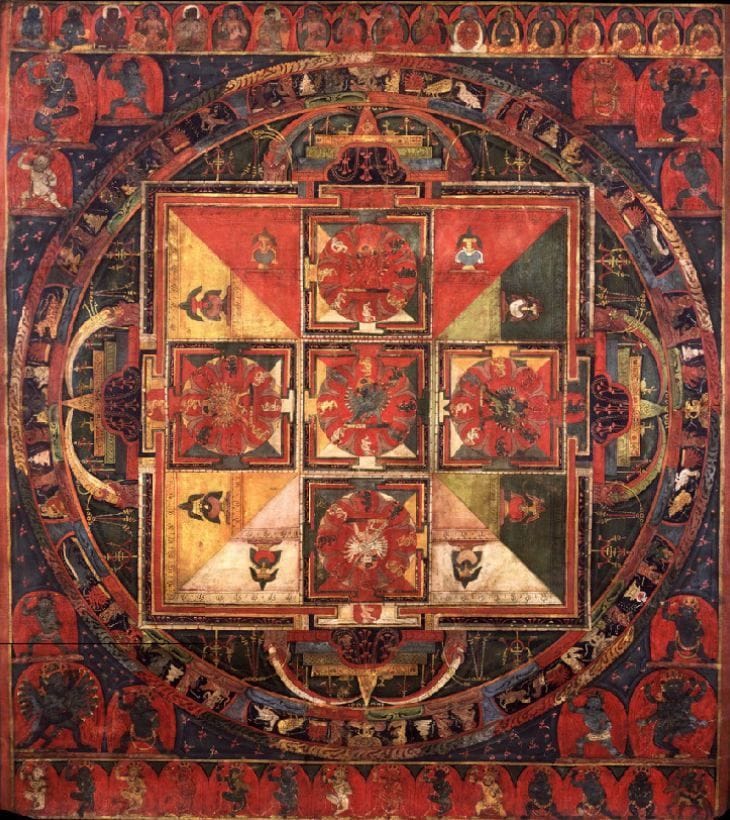

喜金刚坛城 Mandala of Hevajra - Combined Families (Vajrapanjara Tantra) 15世纪, 1400-1499
Unknown
Shri Hevajra Panchadaka Mandala (Tibetan: pal gye pa dor je rig du kyil kor. English: The Combined Glorious Hevajra Five Lords Mandala) with 49 Deities from the Vajrapanjara Tantra. Bibliographic reference: Arya Dakinivajrapanjara Mahatantrarajakalpa Nama
Sanskrit: Hevajra Tibetan: Gye pa dor je
Within the center of the two-dimensional circular diagram (mandala) representing the top view of a three-dimensional celestial palace and surroundings are five smaller square mandalas each containing a form of Shri Hevajra with 9 deities. In the central square is Akshobhya-Hevajra, blue in color, with 8 faces, 16 hands holding skullcups and four legs in a dancing posture. The first pair of hands embrace the consort Vajra Nairatmya(Selfless One), dark blue, with one face and two hands holding a curved knife and skullcup, standing on the left leg with the right embracing Hevajra. They stand atop four corpses within the flames of pristine awareness surrounded by eight goddesses of various colors, each with one face and two hands, standing in a dancing posture on the left leg above a corpse and lotus seat. Beginning from the top and moving in a clockwise direction is Vetali, Dombini, Ghashmari, Pukkashi, Gauri, Shavari, Chauri, and Chandali. They all hold their own distinct hand objects.
Surrounding the Akshobhya Hevajra mandala, in the square above, is the deity Amitabha-Hevajra, red in color, embracing the consort red Pandara Vasini. In the square to the right is Amoghasiddhi-Hevajra, green in colour, embracing light green Samaya Tara. In the square below is Vairochana-Hevajra, white in color, embracing pink Vajradhatvishvari. In the square to the left is Ratnasambhava-Hevajra, yellow in color, embracing orange Buddha Locani. Surrounded by their own unique circle of variously colored 8 goddesses each set of figures is otherwise identical in appearance to the central Hevajra.
The floor of the celestial palace is divided into four colors: red, green, white and yellow. Four empowerment vases adorn the four squares of the intermediate directions. The outer red, blue and white lines forming a square enclosure represent the red veranda outside of the palace walls and the stylized decorative facade on the four sides of the palace roof; adorned with upright spears, arrows and banners. The elaborate lintels above each of the four doors ('T' shaped) are constructed of four tiered steps, red, blue, green, and yellow, topped with a Dharma wheel and two reclining deer with a silk canopy above. The palace is placed squarely on a horizontal multi-coloured double vajra (Sanskrit: visvavajra) with only the prongs and makara heads (an Indian mythological sea creature) appearing on the four sides. Surrounding that is a circle of multi-colored (rectangular) lotus petals (Skt.: padmavali) representing the enormous lotus upon which the entire palace structure rests.
The outer circle containing eight sets of various figures is the ring of the eight great charnel grounds: Gruesome, Frightful with Skulls, Adorned with a Blazing Garland, Dense Jungle, Fiercely Resounding, Forest of the Lord, Dark and Terrible and Resounding with the Cries Kili Kili. They are filled with corpses, fires, chaityas, yogis, nagas, wild animals and wrathful worldly deities. The final ring is composed of the multi-coloured fires (Skt.: jvalavali) of pristine awareness completely enveloping the entire Hevajra Pancadaka Mandala.
Along the top are the lineage gurus. Starting from the left is the primordial buddha Vajradhara, followed by Nairatmya, Virupa, and Dombi Heruka riding a tiger along with various Indian mahasiddhas and Tibetan lamas down to Sachen Kunga Nyingpo and his descendants.
On the outside of the mandala circle starting at the left is solitary Hevajra, blue, with one face and two hands, accompanied by two wrathful figures. On the right is Hevajra, blue, with one face and four hands embracing the consort blue Vajravarahi, accompanied by two wrathful figures. At the bottom right is Hevajra, blue, with three faces and six hands embracing blue Vajrashrinkhala, accompanied by two wrathful figures. At the bottom left is the Essence Shri Hevajra, blue, with 8 faces and 16 hands embracing Vajra Nairatmya, accompanied by two wrathful figures.
Along the bottom starting at the left are 9 goddesses of various colours with one face and two hands, standing in a dancing posture. At the right is yellow Ushnisha Chakravartin, wrathful with one face and two hands, followed by blue Humkara and blue Shumbharaja. At the right corner is the wrathful wisdom protector Panjarnata Mahakala, black, with one face and two hands and Shri Devi, black, with one face and four hands, riding a mule.
Shri Hevajra Panchadaka is a tutelary deity of the Anuttarayoga non-dual classification. From the many Hevajra Tantras this representation arises from the Vajra Panjara Tantra and was popularized in India by the pandit Abhayakaragupta and in Tibet by the Sakyapa and Ngog Lotsawa Lineages.
Lineage: Vajradhara, Nairatmya, Virupa, Acharya Dombi Heruka, Alala Vajra, Nag Tropa, Garbharipa, Jaya Shrjnana, Acharya Durjayachandra, Bikshu Viravajra, Drogmi Lotsawa, Ngaripa Salwai Nyingpo, Khon Gyichuwa Drala Bar, Sachen Kunga Nyingpo (1092-1158), etc.
[http://www.datathangka.com/tkdetail.asp?id=909]
The style of the painting is Nepali, evidenced by rigid geometric form, the use of bright red and blue colours and the intricate floral patterns used in the background design and flame patterns.
Jeff Watt 6-98
[http://www.datathangka.com/tkdetail.asp?id=909]
Uploaded on May 16, 2018 by Suzan Hamer
Unknown
artistArthur
Wait what?
